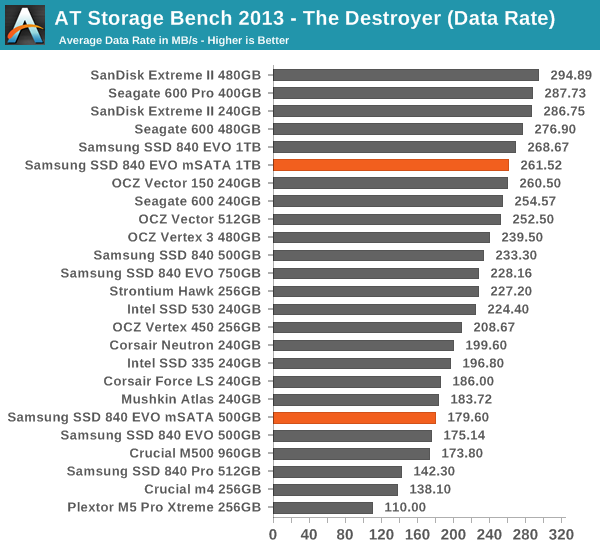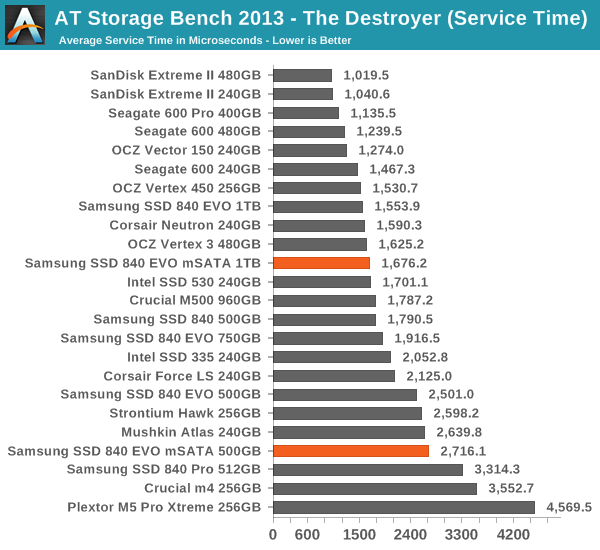Samsung SSD 840 EVO mSATA (120GB, 250GB, 500GB & 1TB) Review
by Kristian Vättö on January 9, 2014 1:35 PM ESTAnandTech Storage Bench 2013
When Anand built the AnandTech Heavy and Light Storage Bench suites in 2011 he did so because we did not have any good tools at the time that would begin to stress a drive's garbage collection routines. Once all blocks have a sufficient number of used pages, all further writes will inevitably trigger some sort of garbage collection/block recycling algorithm. Our Heavy 2011 test in particular was designed to do just this. By hitting the test SSD with a large enough and write intensive enough workload, we could ensure that some amount of GC would happen.
There were a couple of issues with our 2011 tests that we've been wanting to rectify however. First off, all of our 2011 tests were built using Windows 7 x64 pre-SP1, which meant there were potentially some 4K alignment issues that wouldn't exist had we built the trace on a system with SP1. This didn't really impact most SSDs but it proved to be a problem with some hard drives. Secondly, and more recently, we've shifted focus from simply triggering GC routines to really looking at worst-case scenario performance after prolonged random IO.
For years we'd felt the negative impacts of inconsistent IO performance with all SSDs, but until the S3700 showed up we didn't think to actually measure and visualize IO consistency. The problem with our IO consistency tests is that they are very focused on 4KB random writes at high queue depths and full LBA spans–not exactly a real world client usage model. The aspects of SSD architecture that those tests stress however are very important, and none of our existing tests were doing a good job of quantifying that.
We needed an updated heavy test, one that dealt with an even larger set of data and one that somehow incorporated IO consistency into its metrics. We think we have that test. The new benchmark doesn't even have a name, we've just been calling it The Destroyer (although AnandTech Storage Bench 2013 is likely a better fit for PR reasons).
Everything about this new test is bigger and better. The test platform moves to Windows 8 Pro x64. The workload is far more realistic. Just as before, this is an application trace based test–we record all IO requests made to a test system, then play them back on the drive we're measuring and run statistical analysis on the drive's responses.
Imitating most modern benchmarks Anand crafted the Destroyer out of a series of scenarios. For this benchmark we focused heavily on Photo editing, Gaming, Virtualization, General Productivity, Video Playback and Application Development. Rough descriptions of the various scenarios are in the table below:
| AnandTech Storage Bench 2013 Preview - The Destroyer | ||||||||||||
| Workload | Description | Applications Used | ||||||||||
| Photo Sync/Editing | Import images, edit, export | Adobe Photoshop CS6, Adobe Lightroom 4, Dropbox | ||||||||||
| Gaming | Download/install games, play games | Steam, Deus Ex, Skyrim, Starcraft 2, BioShock Infinite | ||||||||||
| Virtualization | Run/manage VM, use general apps inside VM | VirtualBox | ||||||||||
| General Productivity | Browse the web, manage local email, copy files, encrypt/decrypt files, backup system, download content, virus/malware scan | Chrome, IE10, Outlook, Windows 8, AxCrypt, uTorrent, AdAware | ||||||||||
| Video Playback | Copy and watch movies | Windows 8 | ||||||||||
| Application Development | Compile projects, check out code, download code samples | Visual Studio 2012 | ||||||||||
While some tasks remained independent, many were stitched together (e.g. system backups would take place while other scenarios were taking place). The overall stats give some justification to what we've been calling this test internally:
| AnandTech Storage Bench 2013 Preview - The Destroyer, Specs | |||||||||||||
| The Destroyer (2013) | Heavy 2011 | ||||||||||||
| Reads | 38.83 million | 2.17 million | |||||||||||
| Writes | 10.98 million | 1.78 million | |||||||||||
| Total IO Operations | 49.8 million | 3.99 million | |||||||||||
| Total GB Read | 1583.02 GB | 48.63 GB | |||||||||||
| Total GB Written | 875.62 GB | 106.32 GB | |||||||||||
| Average Queue Depth | ~5.5 | ~4.6 | |||||||||||
| Focus | Worst-case multitasking, IO consistency | Peak IO, basic GC routines | |||||||||||
SSDs have grown in their performance abilities over the years, so we wanted a new test that could really push high queue depths at times. The average queue depth is still realistic for a client workload, but the Destroyer has some very demanding peaks. When we first introduced the Heavy 2011 test, some drives would take multiple hours to complete it; today most high performance SSDs can finish the test in under 90 minutes. The Destroyer? So far the fastest we've seen it go is 10 hours. Most high performance SSDs we've tested seem to need around 12–13 hours per run, with mainstream drives taking closer to 24 hours. The read/write balance is also a lot more realistic than in the Heavy 2011 test. Back in 2011 we just needed something that had a ton of writes so we could start separating the good from the bad. Now that the drives have matured, we felt a test that was a bit more balanced would be a better idea.
Despite the balance recalibration, there is just a ton of data moving around in this test. Ultimately the sheer volume of data here and the fact that there's a good amount of random IO courtesy of all of the multitasking (e.g. background VM work, background photo exports/syncs, etc...) makes the Destroyer do a far better job of giving credit for performance consistency than the old Heavy 2011 test. Both tests are valid; they just stress/showcase different things. As the days of begging for better random IO performance and basic GC intelligence are over, we wanted a test that would give us a bit more of what we're interested in these days. As Anand mentioned in the S3700 review, having good worst-case IO performance and consistency matters just as much to client users as it does to enterprise users.
We are reporting two primary metrics with the Destroyer: average data rate in MB/s and average service time in microseconds. The former gives you an idea of the throughput of the drive during the time that it was running the Destroyer workload. This can be a very good indication of overall performance. What average data rate doesn't do a good job of is taking into account response time of very bursty (read: high queue depth) IO. By reporting average service time we heavily weigh latency for queued IOs. You'll note that this is a metric we've been reporting in our enterprise benchmarks for a while now. With the client tests maturing, the time was right for a little convergence.

Update: It appears that something was off in the first run as the 1TB scored 261.52MB/s when I retested it.
I'm not sure if I'm comfortable with the score above. There are no other benchmarks that would indicate the EVO mSATA to be over 20% faster than the 2.5" EVO, so I'm thinking there has been some kind of an error in the test. Unfortunately I didn't have time to rerun the test because The Destroyer takes roughly 12 hours to run and another eight or so hours to be analyzed. However, I managed to run it on the 500GB EVO mSATA and as the graph above shows, its performance is on-par with the 2.5" EVO. I'll rerun the test on the 1TB sample once I get back and will update this based on its output.











65 Comments
View All Comments
wingless - Thursday, January 9, 2014 - link
1TB in that small package?! 2014 is really the FUTURE! This will turn my laptop into a monster.Samus - Thursday, January 9, 2014 - link
What's interesting is it isn't even worth considering these models UNLESS you go with 1TB, because all the other capacities aren't nearly price competitive with the competition. Fortunately for Samsung, there is no competition at the flagship capacity, so they could charge whatever they want.Kristian Vättö - Friday, January 10, 2014 - link
Like I said, those are MSRPs, not street prices. The MSRPs of the 2.5" EVO are only $10 less but as you can see, the street prices are significantly lower.TheSlamma - Wednesday, January 15, 2014 - link
it's the presentjaydee - Thursday, January 9, 2014 - link
Hard for me to justify the 48-55% price premium of the 840 EVO over the Crucial M500 (250 GB and 500 GB versions). At some point "faster" SSD's hits diminishing returns in "real life" scenario's...fokka - Thursday, January 9, 2014 - link
"I wasn't able to find the EVO mSATA on sale anywhere yet, hence the prices in the table are the MSRPs provided by Samsung. For the record, the MSRPs for EVO mSATA are only $10 higher than 2.5" EVO's, so I fully expect the prices to end up being close to what the 2.5" EVO currently retails for."meaning: the prices will go down, once broadly available.
emn13 - Thursday, January 9, 2014 - link
On the desktop? Given the lack of power-loss protection, the 840 EVO is probably a worse choice even at comparable prices.But on mobile? Sudden power loss is less likely (though background GC complicates that picture), and the 840 EVO's lower power draw, particularly in idle, extends battery life.
I'm pretty sure I'd opt for the 840 EVO on a battery-powered device, assuming the price difference isn't too great.
nathanddrews - Thursday, January 9, 2014 - link
If it helps your decision at all, I just upgraded my wife's notebook (Lenovo Y580) from a 2.5" 250GB Samsung 840 (not pro) to an mSATA 240GB Crucial M500 (and then put the stock 750GB HDD back in) and it's phenomenal. The M500 feels snappier, but that could just be due to restoring the existing Windows image onto a clean drive. Either way, it was a great $130 upgrade.If you have a free mSATA port on your notebook, it's a no-brainer to get an SSD for it.
Solid State Brain - Thursday, January 9, 2014 - link
The trim behavior might be something introduced with one of the latest firmwares. I have a Samsung 840 250GB and I recently tried doing some steady state tests. After hammering it with writes, trim does not restore performance immediately. However with normal usage/light workloads, or keeping the drive idle, however, it will eventually (in a matter of hours) return back to the initial performance.I guess this is some kind of strategy to improve long term wear/stability/write endurance. Maybe some sustained write protection kicks in to avoid writing immediately at full speed after trimming the free space.
Solid State Brain - Thursday, January 9, 2014 - link
PS: where's the edit button to fix typos/errors, etc, when needed?? :(